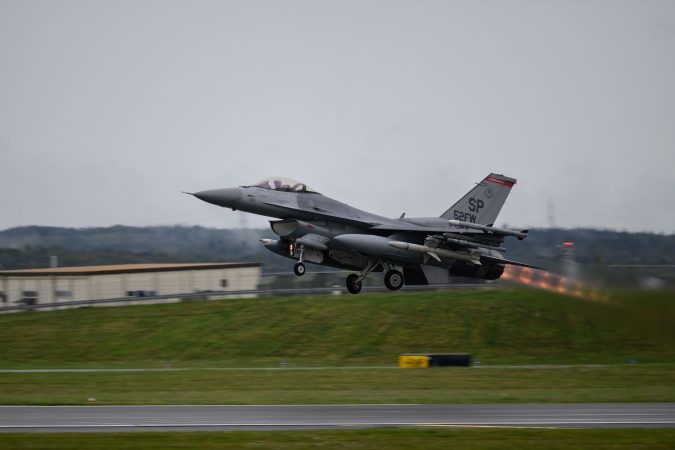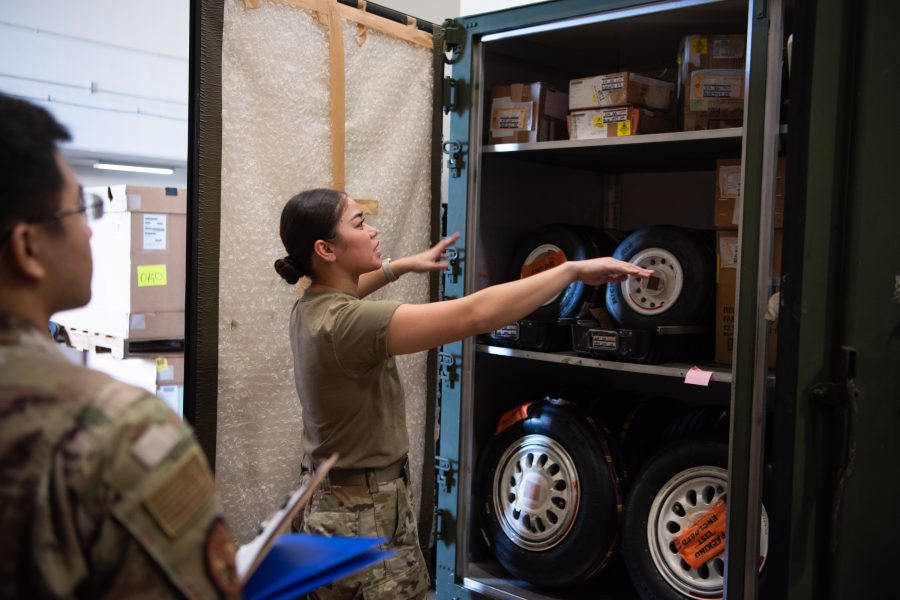NATIONAL HARBOR, Md.—Getting Air Force readiness back where it needs to be—something new Secretary Troy E. Meink has quickly made one of his top priorities—will take parts, flying hours, maintainers, and new aircraft. But even if the service fills the funding accounts for those things in its next budget, they won’t appear right away, a top general said at AFA’s Air, Space & Cyber Conference this week.
China’s air force, meanwhile, is flush with many of those resources, experts at the conference said.
Spare parts for aircraft are one of the key items for restoring Air Force readiness, Maj. Gen. John M. Klein Jr., assistant deputy chief of staff for operations, told Air and Space Forces Magazine.
“Our Weapon System Sustainment accounts are at about 80 percent of the requirement,” Klein said. “If we got them up to 99 percent tomorrow, it would probably take about two years” for contractors to ramp up production of the necessary parts.
That also assumes the parts are in production; some essential parts are no longer made, he noted: “We didn’t buy them when we should have.”
But parts alone won’t fix readiness, he said.
“There’s no silver bullet,” he said. “You need maintainers to fix those aircraft, and it takes me five to seven years to grow” a seasoned aircraft maintainer.
More spare parts and maintenance enable Air Force pilots to fly the hours needed to be combat proficient in their aircraft, he said.
“It all kind of has to rise at the same time,” he said. Without ready aircraft, there aren’t enough to go around to give pilots the hours they need to build true combat proficiency.
John Venable, a retired Air Force colonel and now a fellow with AFA’s Mitchell Institute for Aerospace Studies said that as a young F-16 pilot in the 1980s, he got 350 flying hours per year.
“The average pilot got over 200 and we considered anyone who got less than 150 hours non-combat capable. We would not send them to war,” he said. By comparison, the Air Force now requires between 100-110 hours, depending on the experience level of the pilot.
“We haven’t met that in several years, ladies and gentlemen, and that’s the minimum. The numbers of hours our guys are getting are less than 120” per year, Venable said.

China
Chinese pilots, meanwhile, are averaging around 200 flying hours per year, Venable said, and China has also upgraded the People’s Liberation Army Air Force with fourth- or fifth-generation fighters, backed by plenty of munitions.
“They have 1,100 [aircraft] that can sortie over Taiwan without refueling,” Venable said. “We would be challenged with that … our sortie durations would be much longer. So capacity is on their side. Twenty-four percent of our fighter fleet is stealth. We got there not by adding more fighters, but by subtracting the older fighters.”
Pilot experience, capacity, and readiness “was our big edge during the Cold War,” Venable continued. Restoring that “begins today. It doesn’t begin in seven years,” he said.
Similarly, Venable argued the Air Force cannot rely on future development programs like the F-47 to deter China. A new capability in the laboratory “doesn’t impress Xi at all,” Venable said, referring to Chinese leader Xi Jingping. He and Russian president Vladimir Putin won’t be deterred “unless they see something on the other side of the line that looks vicious … and could do grave damage to their military.”
Another key element in air superiority and deterrence is making sure an adversary knows there is no area not at risk, said Maj. Gen. Parker Wright, deputy commander of Air University. Granting “sanctuary” provides the enemy with a place to reconstitute. “They can build forces, they can plan, they can operate with impunity inside that space,” he said. It also tells them “very clearly … that we won’t take the fight further.”
Retired Lt. Gen. David Deptula, head of the Mitchell Institute, said China should not be granted any such “sanctuary.”
“I’ll be a little bit more blunt. … The Chinese need to understand that their mainland is not off-limits, and that they will be attacked and they will suffer, and if they want to enter into a conflict with the United States, regardless of where it is, their homeland is at risk,” he said.
Air Superiority
While USAF leaders work to restore readiness to achieve air superiority, some observers have questioned whether the rise of small drones in the Russia-Ukraine war spells the end of the need for such air superiority. But officials argued the opposite.
“I would say the Ukraine/Russia scenario is what happens when a military does not have air superiority,” Klein said. “It very quickly devolves into a war of attrition, which is exactly what we’re seeing. It is what I would call trench warfare, a couple hundred feet above the ground.”
Because neither side achieved air superiority—which enables all other forms of maneuver by giving the side that has it freedom of action—”it’s … largely a stalemate,” and the situation is better described as “air parity,” Klein said, asking, “Is this how we want to fight the next war?”
By contrast, Israel’s recent “12-Day War” with Iran was a definitive application of airpower to achieve air supremacy, he said.
“Israel did have the capability and capacity to put together a well-crafted and synchronized air campaign,” Klein said. This “set the conditions” for Israel’s action and the follow-up raid on Iran’s nuclear development facilities, carried out by more than 100 U.S. aircraft.
“We achieved localized, episodic air superiority, which allowed some follow-on strategic objectives to be met. So you know, air superiority absolutely remains essential for large-scale combat operations,” he said.
Maj. Gen. William Betts, head of plans and programs for Air Combat Command, said the Ukraine war also is a definitive signal that America’s unquestioned dominance of the air, which it has enjoyed for 30 years, cannot be assumed any longer.
“It is a reminder that we have to continue to emphasize that air superiority is not our manifest destiny. It’s something we have to fight for,” he said.


